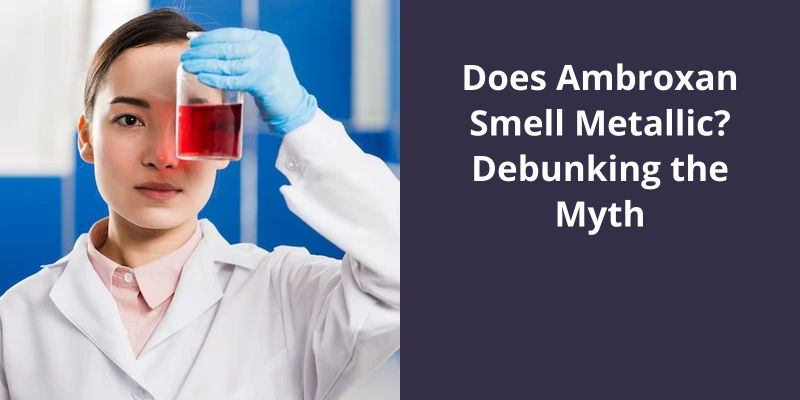Ambroxan does not have a metallic smell. It is a synthetic ingredient often used in the perfume industry for its ability to prolong the scent. Ambroxan is often described as having a sweet, ambery, musky, and slightly woody smell. It can also have salty facets, likened to the scent of a warm, salty sea breeze. While some people may describe it as having a ‘mineral’ or ‘metallic’ nuance, it is not predominantly metallic in nature. This element may just be part of the complexity of its scent profile and how it interacts with other fragrance ingredients and the wearer’s unique skin chemistry.

Can Some People Not Smell Ambroxan?
Anosmia can be caused by a variety of factors, including genetics, nasal disorders, head injuries, and certain medications. For those who’re unable to smell ambroxan, it may be due to a genetic variation in their olfactory receptor genes. Olfactory receptors are responsible for detecting specific odor molecules in the air, and any variation in these genes can lead to differences in the ability to detect scents.
It’s important to note that not being able to smell ambroxan doesn’t necessarily mean that a person has anosmia. There are many other scent molecules that a person may not be able to detect due to their unique genetic makeup or other factors. Additionally, some perfumes may contain a combination of scent molecules that interact with each other, making it difficult to isolate the specific scent of ambroxan.
Interestingly, the ability to detect certain scents can also vary depending on a persons age and gender. For example, women generally have a better sense of smell than men, and older individuals may experience a gradual decline in their ability to detect certain scents.
The Role of Ambroxan in Perfumery and Fragrance Industry
- Ambroxan is a synthetic fragrance compound used in perfumery.
- It’s an amber-like scent and is often used as a replacement for ambergris.
- Ambroxan is commonly used in fragrances for both men and women and is known for it’s long-lasting scent.
- It’s also used in household and personal care products, such as scented candles and body lotions.
- Ambroxan has a strong and distinct odor that can be overpowering if used in excess.
- The use of ambroxan in perfumery is a topic of debate among fragrance enthusiasts and professionals.
- Some argue that it’s overused and has become a common, uninteresting note in modern perfumery.
- Others believe that when used in moderation and paired with the right ingredients, ambroxan can create unique and beautiful fragrances.
Now that we’ve established Ambroxan’s role as a base note in perfumes, let’s take a closer look at it’s unique properties and how it can affect the overall scent of a fragrance.
Is Ambroxan a Base Note?
Ambroxan is a synthetic compound that’s widely used in perfumery as a base note. As a base note, it serves as the foundation of a fragrance and provides a warm and long-lasting scent. It’s derived from ambergris, a rare substance found in the digestive system of whales. Unlike natural ambergris, ambroxan is a synthetic version, which means it can be produced in a laboratory and is environmentally friendly.
It’s often used in combination with other base notes such as musks, animalics, and woods to create a well-balanced fragrance. The compound has a slow evaporation rate, which allows it to provide a long-lasting scent to a fragrance. This property is why it’s so popular among perfumers.
Perfumers use ambroxan in a wide range of fragrances, from masculine to feminine scents. It’s a versatile compound that blends well with a variety of ingredients, including citrus, floral, and fruity notes. Additionally, ambroxan is instrumental in creating designer perfumes such as Prada LHomme, Dior Sauvage, and Narciso Rodriguez For Him.
It’s a woody and sweet scent and provides an excellent longevity to a fragrance. The compound is versatile and blends well with a wide range of ingredients, making it an essential ingredient in many perfumes. Due to it’s synthetic nature, it’s also environmentally friendly and more affordable than natural ingredients.
The Chemistry Behind the Production of Ambroxan in a Laboratory
- Ambroxan is a synthetic compound that’s used in perfumery for it’s amber-like scent.
- The production of ambroxan involves the reaction of ambergris with chemicals such as benzene and acetic anhydride.
- During the reaction, the ambergris is broken down into smaller molecules, which then react with the other chemicals to produce ambroxan.
- The final product is a white or pale-yellow crystalline solid that’s a musky, woody odor.
- Ambroxan is often used as a fixative in perfumes, helping to extend the lifespan of the fragrance.
- The chemical structure of ambroxan is similar to that of ambergris, which is a rare and expensive natural material that’s harvested from the intestines of whales.
- By producing ambroxan in a laboratory, perfumers are able to create a similar scent profile without relying on this controversial and unsustainable material.
Conclusion
While some experts argue that it does have a metallic odor due to it’s chemical composition, others claim that this may not be the case. Ultimately, the olfactory experience is subjective, with each individual interpreting scents differently.





